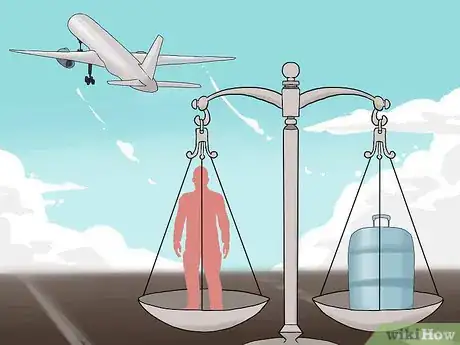This article was co-authored by wikiHow Staff. Our trained team of editors and researchers validate articles for accuracy and comprehensiveness. wikiHow's Content Management Team carefully monitors the work from our editorial staff to ensure that each article is backed by trusted research and meets our high quality standards.
This article has been viewed 148,381 times.
Learn more...
The term “payload” literally refers to the load that’s being paid to be transported. Calculating how much of a payload you can fit onto an aircraft isn’t super complicated, but it’s really important that you get it right so the plane isn’t overloaded. To make it even easier, we’ve answered a few common questions about what it takes to accurately calculate your aircraft payload so you can feel confident you’re doing it correctly.
Steps
Community Q&A
-
QuestionHow do I balance fuel in a 777 aircraft?
 Community AnswerFuel imbalance can be fixed by activating cross-feed valves located on the upper overhead panel, next to the fuel pumps. Just check for fuel leaks (in this case do not activate the valves unless you want to become a glider!) and wait for a couple of minutes. It should fix soon. Then you can disable the valves.
Community AnswerFuel imbalance can be fixed by activating cross-feed valves located on the upper overhead panel, next to the fuel pumps. Just check for fuel leaks (in this case do not activate the valves unless you want to become a glider!) and wait for a couple of minutes. It should fix soon. Then you can disable the valves. -
QuestionIs it true that the air alone weighs one ton inside an empty Antonov 225?
 Community AnswerAccording to wiki its volume is 1300 m^3, which at see level weights about 1650 kg -- so more than a ton. But you don't usually calculate air weight, since air outside of the aircraft has weight too, and thus gives buoyancy to aircraft which equals the before-mentioned weight. Of course, at higher latitude that weight-to-buoyancy ratio will change due to difference in pressure. Like at 40,000 feet the weight of the air inside due to the 10,000-foot level cabin pressure could be 800 kg, while buoyancy could only be something like 200 kg. But since the most critical stages are take off and landing we don't consider this weight difference.
Community AnswerAccording to wiki its volume is 1300 m^3, which at see level weights about 1650 kg -- so more than a ton. But you don't usually calculate air weight, since air outside of the aircraft has weight too, and thus gives buoyancy to aircraft which equals the before-mentioned weight. Of course, at higher latitude that weight-to-buoyancy ratio will change due to difference in pressure. Like at 40,000 feet the weight of the air inside due to the 10,000-foot level cabin pressure could be 800 kg, while buoyancy could only be something like 200 kg. But since the most critical stages are take off and landing we don't consider this weight difference.
Warnings
- Never operate an aircraft that exceeds its max payload value! It could potentially cause a crash.⧼thumbs_response⧽
References
- ↑ https://www.aopa.org/news-and-media/all-news/2017/june/pilot/proficiency-payload
- ↑ https://www.aopa.org/news-and-media/all-news/2017/june/pilot/proficiency-payload
- ↑ https://www.aopa.org/news-and-media/all-news/2017/june/pilot/proficiency-payload
- ↑ https://www.faa.gov/regulations_policies/handbooks_manuals/aviation/media/faa-h-8083-1.pdf
- ↑ https://www.law.cornell.edu/definitions/index.php?width=840&height=800&iframe=true&def_id=6d69f1d0000af170730cd4d575155e59&term_occur=2&term_src=Title:14:Chapter:II:Subchapter:A:Part:294:Subpart:A:294.2

















-Step-15.webp)















































